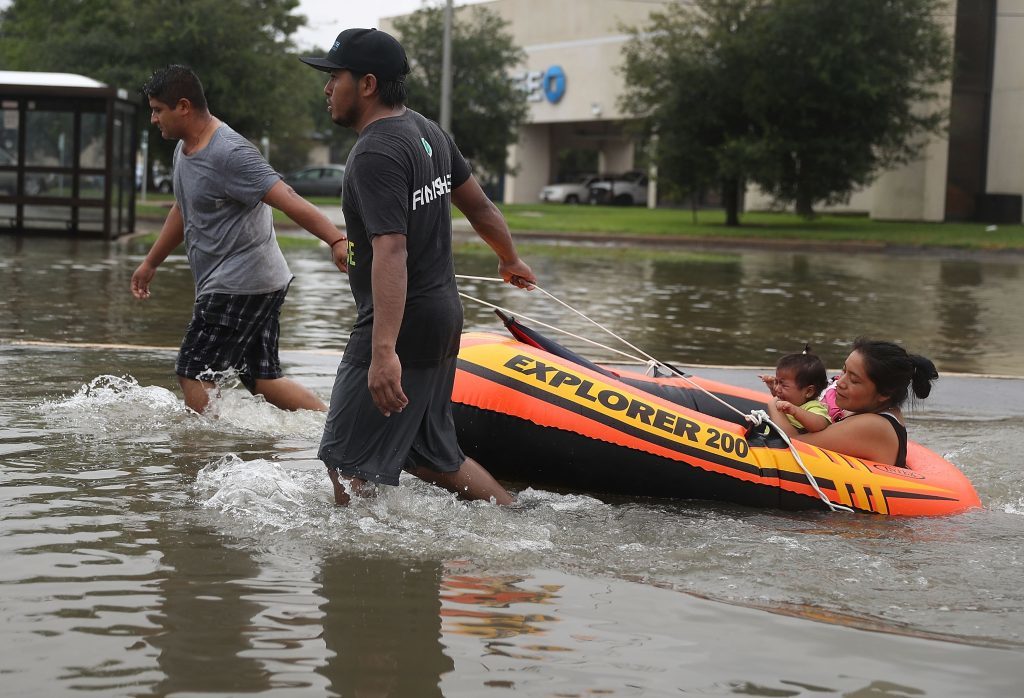
Hurricane Harvey has deluged America’s fourth-largest city with devastating floods, with rising water forcing thousands on to rooftops and overwhelming rescuers receiving constant calls for help.
The incessant rain covered much of Houston, Texas, in dirty grey-green water and turned streets into rivers navigable only by boat.
In a rescue effort that recalled the aftermath of Hurricane Katrina, helicopters landed near flooded freeways, airboats buzzed across submerged neighbourhoods and high-water vehicles ploughed through waterlogged junctions.
Some people managed with kayaks or canoes – or swam.
Volunteers joined emergency teams to pull people from their homes or from the water, which was high enough in places to gush into second floors.
The flooding from Harvey, which made landfall late on Friday as a Category 4 hurricane and has lingered dropping heavy rain as a tropical storm, was so widespread that authorities had trouble pinpointing the worst areas.
They urged people to get on top of their houses to avoid becoming trapped in attics and to wave sheets or towels to draw attention to their location.
People living around the Addicks and Barker reservoirs designed to help prevent flooding in central Houston, were warned that a controlled release from both reservoirs would cause additional street flooding and could spill into homes.
Rising water levels and continuing rain was putting pressure on the dams that could cause a failure without the release.
Judging from national disaster declarations, the storm has so far affected about a quarter of the Texas population, or 6.8 million people in 18 counties, and was blamed for at least two deaths.
As the water rose, the National Weather Service issued another ominous forecast, saying before the storm is gone, some parts of Houston and its suburbs could get as much as 50ins of rain – the highest amount recorded in Texas.
Some areas have already received about half that amount.
Since Thursday, South Houston recorded nearly 25ins and the suburbs of Santa Fe and Dayton had 27ins.
“The breadth and intensity of this rainfall is beyond anything experienced before,” the National Weather Service said.
Average rainfall totals will end up around 40ins for Houston, weather service meteorologist Patrick Burke said.
Brock Long, director of the Federal Emergency Management Agency, predicted that the aftermath of the storm would need Fema’s involvement for years.
“This disaster’s going to be a landmark event,” he said.
Rescuers had to give top priority to life-and-death situations, leaving many affected families to fend for themselves. And several hospitals in the Houston area were evacuated due to the rising waters.
It was not clear how many people were plucked from the floodwaters. Up to 1,200 people had to be rescued in Galveston County alone, said county judge Mark Henry.
Houston’s George R Brown Convention Centre was quickly opened as a shelter. It was used as a shelter for Katrina refugees in 2005.
Gillis Leho, who arrived there soaking wet, said she awoke to find her downstairs flooded. She tried to move some belongings upstairs, then grabbed her grandchildren.
“When they told us the current was getting high, we had to bust a window to get out,” she said.
Some people used inflatable beach toys, rubber rafts and even air mattresses to get through the water to safety. Others waded while carrying rubbish bags stuffed with their belongings and small animals in picnic coolers.
Houston mayor Sylvester Turner said authorities had received more than 2,000 calls for help, with more coming in.
He urged drivers to stay off roads to avoid adding to the number of those stranded.
“I don’t need to tell anyone this is a very, very serious and unprecedented storm,” he said.
“We have several hundred structural flooding reports. We expect that number to rise pretty dramatically.”
The deteriorating situation was bound to provoke questions about the conflicting advice given by the governor and Houston leaders before the hurricane.
Governor Greg Abbott urged people to flee from Harvey’s path, but the mayor issued no evacuation orders and told everyone to stay home.
The governor refused to point fingers on Sunday.
“Now is not the time to second-guess the decisions that were made,” Mr Abbott, a Republican, said.
“What’s important is that everybody work together to ensure that we are going to, first, save lives and, second, help people across the state rebuild.”
Mr Turner, a Democrat, defended his decision, saying there was no way to know which parts of the city were most vulnerable.
“If you think the situation right now is bad, and you give an order to evacuate, you are creating a nightmare,” he said, citing the risks of sending the city’s 2.3 million inhabitants on to the highways at the same time.
The US Coast Guard sent five helicopters and asked for additional aircraft from New Orleans.
The White House said US president Donald Trump would visit Texas on Tuesday.
The rescues unfolded a day after Harvey settled over the Texas coastline.
The system weakened on Saturday to a tropical storm and on Sunday, it was virtually stationary about 25 miles north west of Victoria, Texas, with maximum sustained winds of about 40mph the hurricane centre said.
Harvey was the fiercest hurricane to hit the US in 13 years and the strongest to strike Texas since 1961’s Hurricane Carla, the most powerful Texas hurricane on record.
Recommended for you
